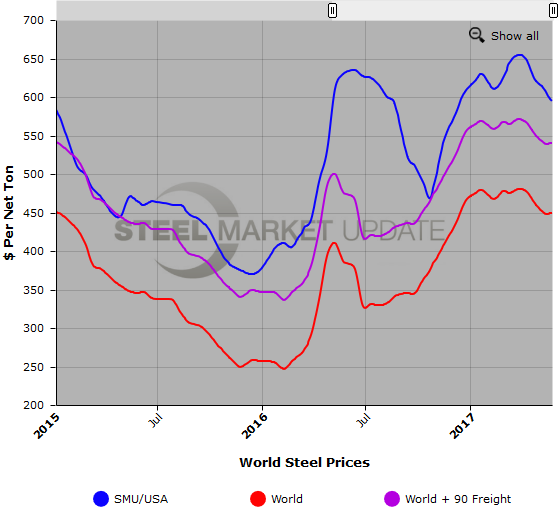International Steel Prices

Foreign vs. Domestic Hot Rolled Price Comparison in May 2017
Written by Brett Linton
May 25, 2017
The following calculation is used by Steel Market Update to identify the theoretical spread between foreign hot rolled steel import prices (delivered to USA ports) and domestic (USA) hot rolled coil prices (FOB Domestic mills). We want our readers to be aware that this is only a “theoretical” calculation as freight costs, trader margin and other costs can fluctuate ultimately influencing the true market spread.
Our primary numbers for this exercise are from Platts as we compare European HRC (FOB Ruhr), Turkey HRC export pricing (FOB Turkey), and Chinese HRC export prices (FOB Chinese port). Be aware that Chinese hot rolled is not available to the U.S. market so the Chinese spread is nothing more than an exercise of what if… SteelBenchmarker is the secondary data provider of foreign hot rolled coil prices and is noted further down in this article.
![]() SMU adds $90 per ton to these foreign prices taking into consideration freight costs, handling, trader margin, etc. This provides an approximate “CIF US ports price” that can then be compared against the SMU US hot rolled price average (FOB Mill), with the result being the spread (difference) between domestic and foreign hot rolled prices. As the price spread narrows, the competitiveness of imported steel into the United States is reduced. If the spread widens, then foreign steel becomes more attractive to US flat rolled steel buyers. A positive spread means US prices are theoretically higher than foreign prices, while a negative spread means US prices are cheaper than foreign prices.
SMU adds $90 per ton to these foreign prices taking into consideration freight costs, handling, trader margin, etc. This provides an approximate “CIF US ports price” that can then be compared against the SMU US hot rolled price average (FOB Mill), with the result being the spread (difference) between domestic and foreign hot rolled prices. As the price spread narrows, the competitiveness of imported steel into the United States is reduced. If the spread widens, then foreign steel becomes more attractive to US flat rolled steel buyers. A positive spread means US prices are theoretically higher than foreign prices, while a negative spread means US prices are cheaper than foreign prices.
As of today (Thursday, May 25th) Platts published European HRC prices at $526 per net ton FOB Ruhr ($518 Euros per metric ton), up $3 from two weeks ago but down $9 from one month ago. Calculating in $90 per ton for import costs, that puts prices at $616 per net ton from Europe delivered to the US. The latest Steel Market Update hot rolled price average is $595 per ton for domestic steel, down $15 per ton compared to the last time we did an update on world prices on May 11th, and down $30 per ton over one month ago. This puts the theoretical spread between European and US HR prices at -$21 per ton, down from -$3 two weeks ago, and down from +$0 one month ago. This means that currently US sourced HR is theoretically $21 per ton cheaper than getting HR steel imported from Europe.
Chinese HRC prices were reported at $397 per net ton ($438 per metric ton), up $29 from two weeks ago and up $16 over one month ago. Adding $90 in estimated import costs, that puts prices around $487 per ton delivered from China (if China were able to ship to the United States, which they are not). The theoretical spread between the Chinese and US HR price is +$108 per ton, down from +$141 per ton two weeks ago and down from +$154 per ton one month ago. Meaning that if Chinese HR were able to be shipped to the US, it would be approximately $108 per ton cheaper than buying domestic steel.
Platts published Turkish export prices at $449 per net ton FOB Turkish port ($495 per metric ton), down $14 over two weeks ago and down $18 from one month ago. Adding $90 in import costs, the Turkish HRC “to the US ports” price is $539 per ton. This puts the theoretical spread between the Turkish and US HR price at +$56 per ton, down from +$57 two weeks ago and down from +$68 one month ago. This means that HR from the US is theoretically $56 per ton more expensive than importing HR from Turkey.
SteelBenchmarker World Export Price
The SteelBenchmarker world export price for hot rolled bands is $450 per net ton ($496 per metric ton) FOB the port of export according to data released by SteelBenchmarker on Monday May 22nd. This is unchanged from the previous release on May 8th and down $13 from one month ago. Adding in $90 in estimated import costs, that puts prices around $540 per ton delivered to the US. As previously mentioned, the latest Steel Market Update hot rolled price average is $595 per ton.
Therefore, the theoretical spread between the SteelBenchmarker world HR export price and the SMU HR price is +$55 per ton, meaning foreign HRC imported into the US is theoretically now $55 per ton cheaper than steel purchased domestically. This spread is down from +$70 from our previous analysis and down from +$72 one month ago.
This $55 spread is around $20 per ton lower than the average spread seen over the last few months. This time last year, the spread was +$153 per ton, and continued on to reach record high spreads over the summer, with the June 27th 2016 spread of +$210 being the record high in our 7+ year recorded history, and the July 14th 2016 spread of +$204 being the second highest. Prior to 2016, the previous highest spread was +$94 in May 2014. The lowest spread in our history was -$70 in August 2011 (meaning domestic steel was theoretically $70 per ton cheaper than foreign steel). The lowest spread in 2017 so far was the February 13th spread of +$52 per ton, so we are approaching those levels again. The average spread for 2017 YTD is +$67.
We want to again remind our readers that the calculations shown above are “theoretical” but in most markets are probably a good indicator of where you can expect to find offers being made. However, we are not living in normal times and the combination of dumping suits and now the Section 232 self-initiation review by the U.S. Department of Commerce is turning the market on its head. We will continue to watch market developments closely.
Freight is an important part of the final determination on whether to import foreign steel or buy from a domestic mill supplier. Domestic prices are referenced as FOB the producing mill while foreign prices are FOB the Port (Houston, NOLA, Savannah, Los Angeles, Camden, etc.). Inland freight, from either a domestic mill or from the port, can dramatically impact the competitiveness of both domestic and foreign steel.
Below is a graph comparing SteelBenchmarker world HR export prices against the SMU domestic HR average price (we will build new data using Platts and replace the SteelBenchmarker data once we have collected a sizable history). We also have included a comparison with freight and traders’ costs added which gives you a better indication of the true price spread. You will need to view the graph on our website to use its interactive features, you can do so by clicking here. If you need assistance with either logging in or navigating the website, please contact us at 800-432-3475 or info@SteelMarketUpdate.com.

Brett Linton
Read more from Brett LintonLatest in International Steel Prices

CRU: Sheet prices stable w/w in most areas of the world
Steel sheet prices in many regions of the world were steady week over week in the week ended April 17.
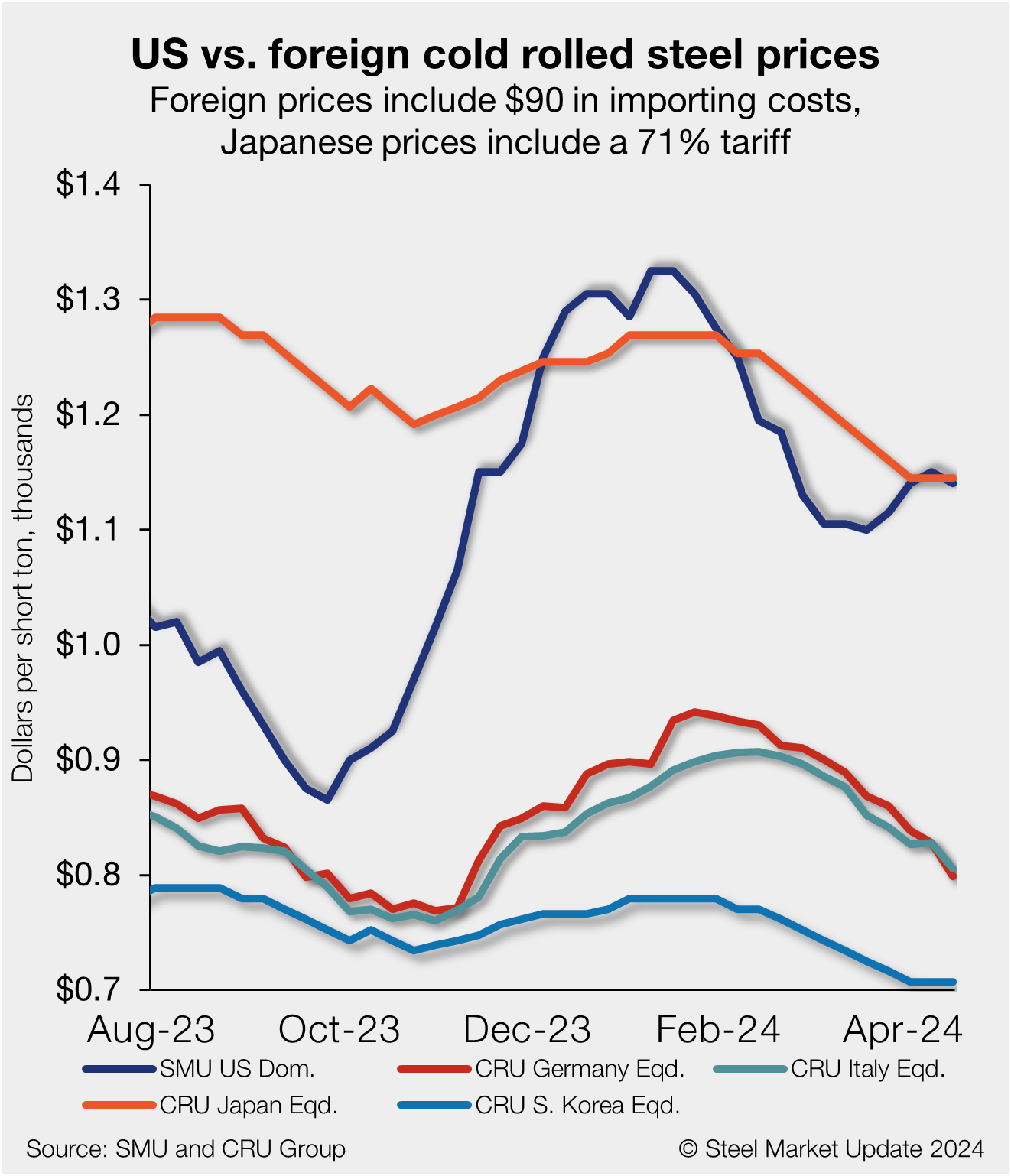
US CR tags 30% more than imports
Foreign cold-rolled (CR) coil remains less expensive than domestic product, according to SMU’s latest check of the market.
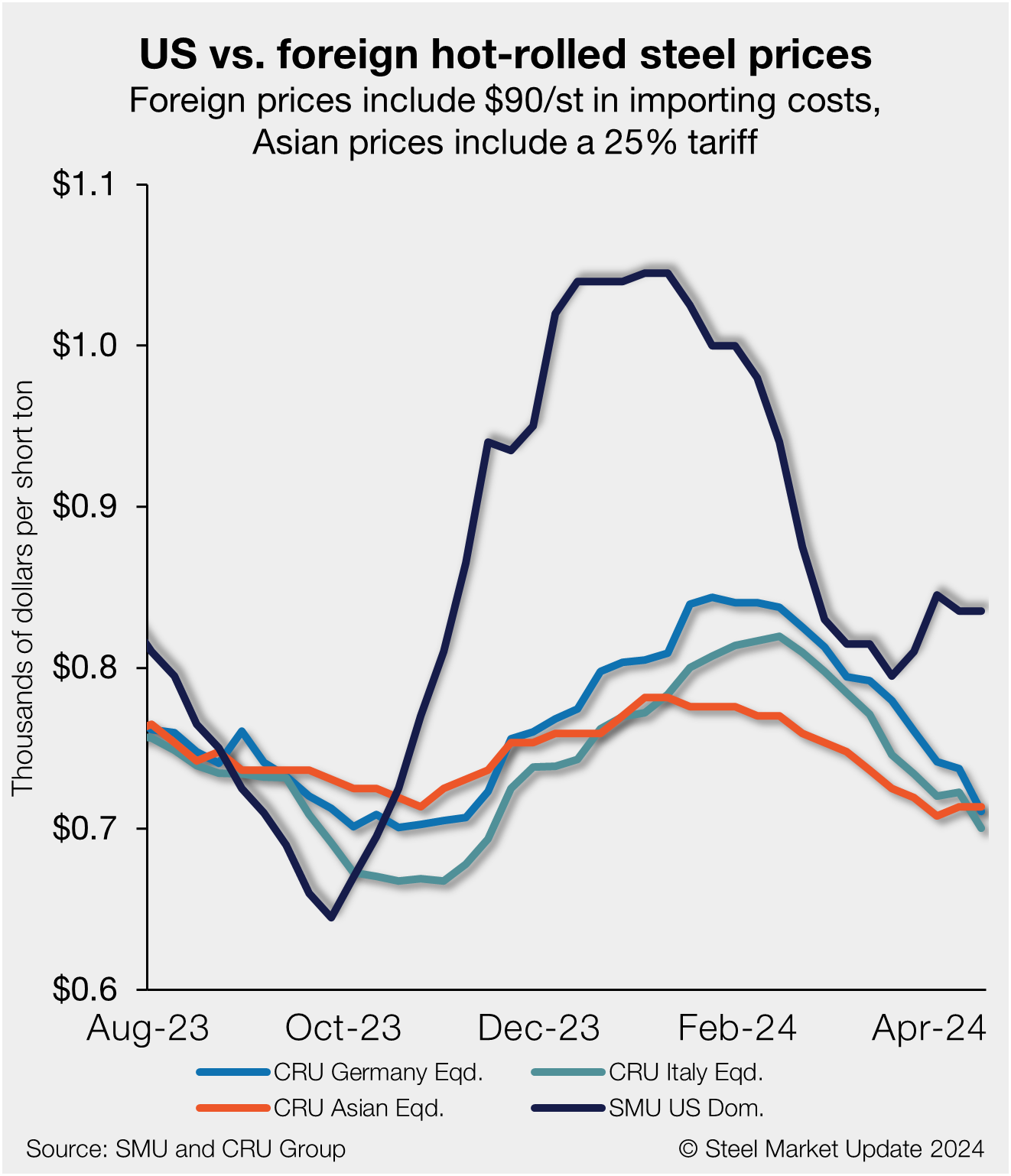
US HR premium widens on lower offshore tags
US hot-rolled (HR) coil has become gradually more expensive than offshore hot band in recent weeks, as stateside prices have stabilized while imports moved lower.
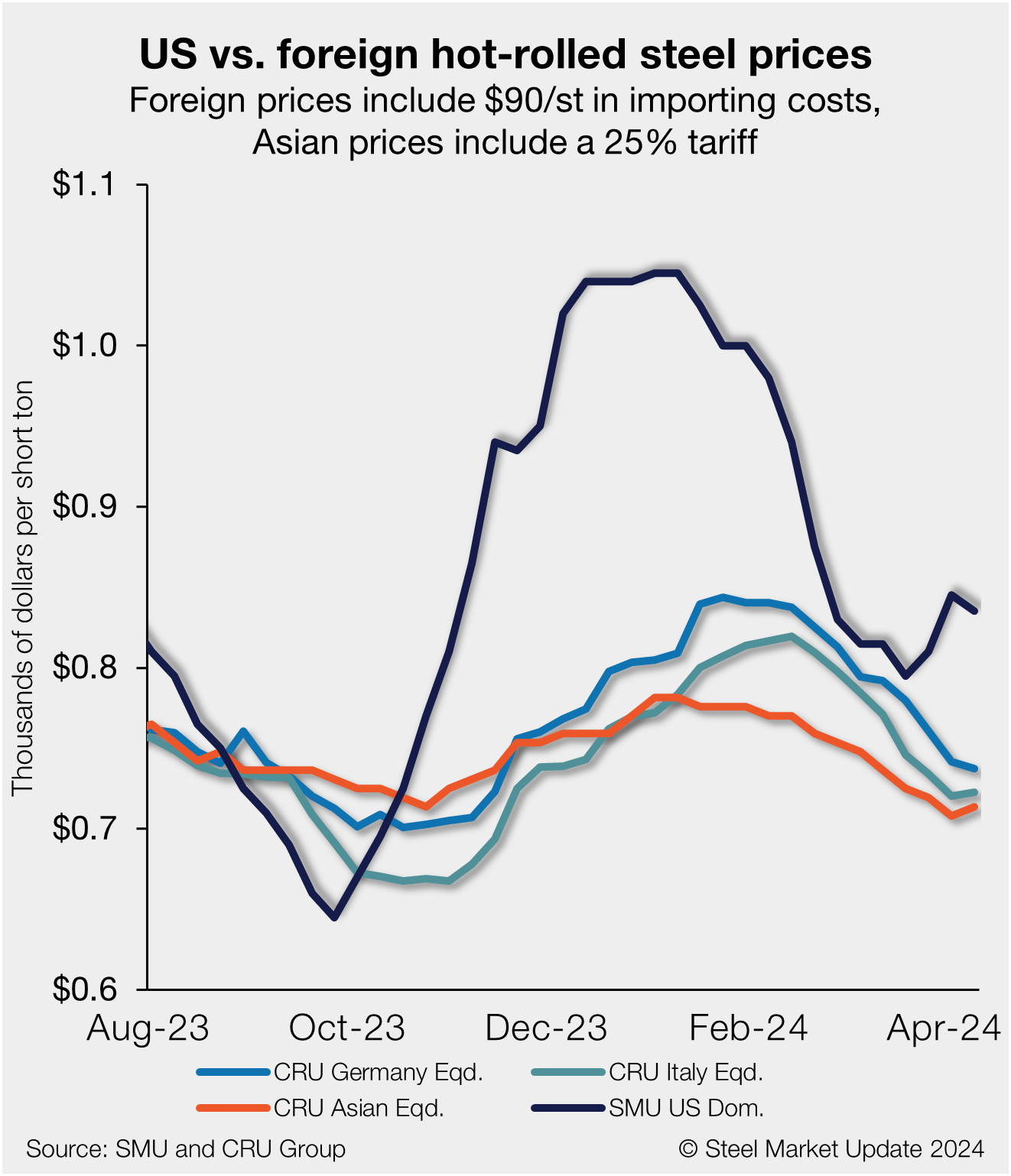
US HR prices slip, though still more expensive than imports
US hot-rolled (HR) coil has become increasingly more expensive than offshore hot band as stateside prices have moved higher at a sharper pace vs. imports.
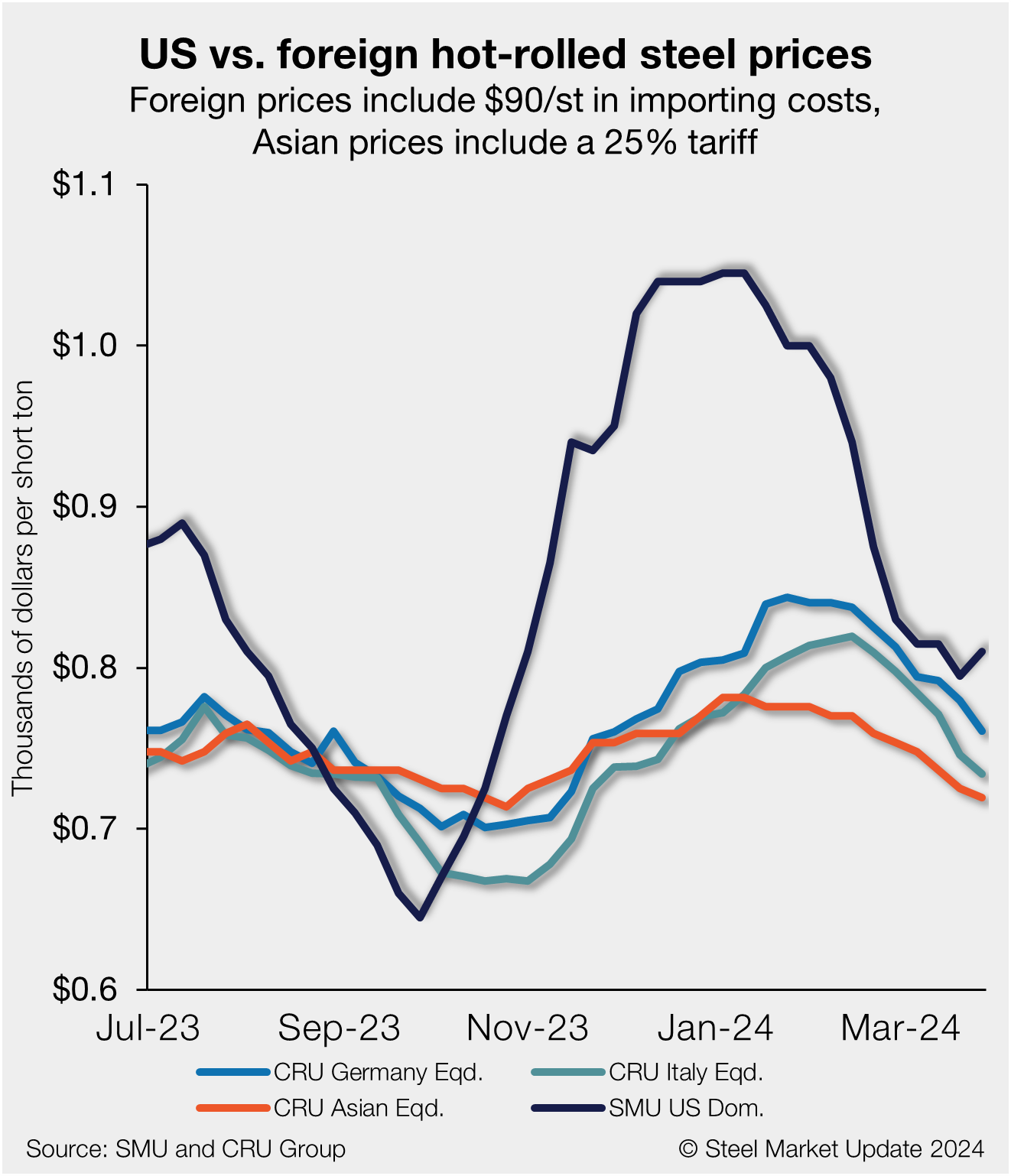
US HR prices rebound, no longer near parity with imports
US hot-rolled coil and offshore hot band moved further away from parity this week as stateside prices have begun to move higher in response to mill increases.

